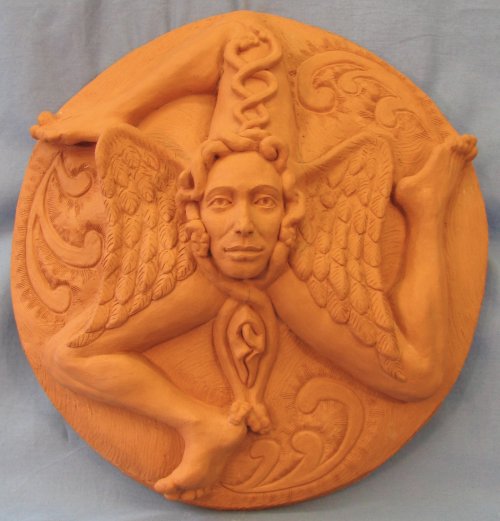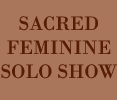
|
|

|
About the Piece In the fourth century B.C. a tryfus (three-foot) or triskelion symbol was adapted for the emblem of Sicily. At this time Sicily was called Trinacria or “Three Capes”, and like the tryfus or triskelion Sicily is triangular in shape. (Barbara Walker, 1988 pg. 43) Even today, the Sicilian Banner bears the trinacria at its center. I am interested in the trinacria because this emblem incorporates many of the symbols I regularly use in my artwork including Medusa, snakes, the yoni, and the wheel of life (swastika). The lunar swastika that rotates in a counterclockwise (widdershins) direction is seen as female, lunar, mysterious and sacred (Barbara Walker, 1988 pg. 55) That the face of Medusa appears at the locus of the yoni in the trinacria is of particular interest to me. This links the yoni to active feminine energy that has a voice, consciousness, and intellect. (for more information about Medusa please see my sculpture Medusa Revisioned.) I have retained most of the elements found in the traditional trinacrea form. One of the changes I did make was to form the snakes at the top of Medusa’s head into the caduceus, the universal symbol of the medical profession. Medusa’s name comes from the same root word as medicine (Babcock). The symbol for female wisdom, the snake, is now linked to Medusa as healer. It is also significant that the wheel of life found in the trinacria has three legs instead of four, whereas the number four is often used in conjunction with masculine themes. The number three, however, is often associated with the Virgin, Mother and Crone. (Barbara Walker, 1988 pg. 34) The number seven was sacred to the ancients because it embodied the unity of the feminine three and the masculine four. (Barbara Walker, 1988 pg. 46) When I was young I was captivated by the story of King Arthur’s daughter Burd Ellen. The Warlock Merlin explains that “because she went round the church windershins—opposite to the sun. She is now in the dark Tower of Elfland.” (Katharine Gibson, 1901 pg. 59) The story concludes “They reached home safely and were welcomed with great joy by fair Gwenevera, their queen mother. And never again did Burd Ellen go round the church or churchyard windershins.” (Katharine Gibson, 1901 pg. 68) Can one extrapolate that Burd Ellen left behind her woman heritage, and all that was female, lunar, mysterious and the essence of herself? Did she instead follow what was exclusively male, symbolized by the sun? Could it be that because the legs of most traditional trinacria move in a lunar (windershins) path, women’s customs are reinstated as constructive through this symbol?
For questions or comments about Cydra's art, please email: womansculpture@icloud.com
|


